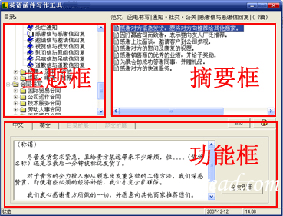《1978年国际海员培训、发证和值班标准公约》的1991年修正案
|
颁布日期:19910101 实施日期:19910101 TABLE OF CONTENTS Chapter I General Provisions Regulation I/1 Definitions Regulation I/2 Content of certificates and form of endorsement Regulation I/4 Control procedures Regulation I/5 Conduct of trails Chapter II Master-Deck Department Appendix to regulation II/2 Appendix to regulation II/4 Regulation II/6 Mandatory minimum requirements for ratings formingpart of a navigational watch Chapter IV Radio Personnel Regulation IV/1 Application Regulation IV/2 Mandatory minimum requirements for certification ofGMDSS radio personnel Appendix to regulation IV/2 Regulation IV/3 Mandatory minimum requirements to ensure thecontinued proficiency and updating of knowledge for GMDSS radio personnel Chapter VI Regulation VI/1 Mandatory minimum requirements for the issueof certificates of proficiency in survival craft and rescue boats Appendix to regulation VI/11991 AMENDMENTS TO THE INTERNATIONAL CONVENTION ON STANDARDS OF TRAINING,CERTIFICATION AND WATCHKEEPING FOR SEAFARERS, 1978 CHAPTER I GENERAL PROVISIONS Regulation I/1 Definitions Replace the existing texts of paragraphs (k) and (1) by: “(k) `Radio operator' means a person holding an appropriatecertificate related to the global maritime distress and safety systemissued or recognized by an Administration under the provisions of theRadio Regulations”。 (p) Replace “IMCO recommendations” by “recommendations of theOrganization”。 (r) Delete “IMCO”。 (s) Delete “IMCO”。 Reletter paragraphs (k) to (s) as (k) to (r)。 Regulation I/2 Content of certificates and form of endorsement Amend the first line of paragraph 2 to read: “In respect of radio operators, Administrations may:”。 Regulation I/4 Control procedures In paragraph 3, replace “radio officer” by “radio operator”。 Add the following new regulation: “Regulation I/5 Conduct of trials 1. These regulations shall not prevent an Administration fromauthorizing ships entitled to fly its flag to participate in trials. 2. For the purposes of this regulation, the term `trial' means anexperiment or series of experiments, conducted over a limited period,which may involve the use of automated or integrated systems in order toevaluate alternative methods of performing specific duties or satisfyingparticular arrangements prescribed by this Convention, which would provideat least the same degree of safety and pollution prevention as provided bythese regulations. 3. The Administration authorizing ships to participate in trials shallbe satisfied that such trials are conducted in a manner that provides atleast the same degree of safety and pollution prevention as provided bythese regulations. Such trials shall be conducted in accordance withguidelines adopted by the Organization. 4. Details of such trials shall be reported to the Organization asearly as practicable but not less than six months before the date on whichthe trials are scheduled to commence. The Organization shall circulatesuch particulars to all Parties. 5. The results of trials authorized under paragraph 1, and anyrecommendations the Administration may have regarding those results, shallbe reported to the Organization which shall circulate such results andrecommendations to all Parties. 6. Any Party having any objection to particular trials authorized inaccordance with this regulation should communicate such objection to theOrganization as early as practicable. The Organization shall circulatedetails of the objection to all Parties. 7. An Administration which has authorized a trial should respectobjections received from other Administrations relating to such trial bydirecting ships entitled to fly its flag not to engage in a trial whilenavigating in the waters of a coastal State which has communicated itsobjection to the Organization. 8. An Administration which concludes, on the basis of a trial, that aparticular system will provide at least the same degree of safety andpollution prevention as provided by these regulations may authorize shipsentitled to fly its flag to continue to operate with such a systemindefinitely, subject to the following requirements: (a) the Administration shall, after results of the trial have beensubmitted in accordance with paragraph 5, provide details of any suchauthorization, including identification of the specific ships which may besubject to the authorization, to the Organization which will circulatethis information to all Parties; (b) any operations authorized under this paragraph shall beconducted in accordance with guidelines as may be developed by theOrganization, to the same extent as they apply during a trial; (c) such operations shall respect any objections received fromother Administrations in accordance with paragraph 7, to the extent suchobjections have not been withdrawn; and (d) an operation authorized under this paragraph shall only bepermitted pending a determination by the Maritime Safety Committee as towhether an amendment to the Convention would be appropriate, and, if so,whether the operation should be suspended or permitted to continue beforethe amendment enters into force. At the request of any Party, the MaritimeSafety Committee shall establish a date for consideration of the trialresults and for the appropriate determinations.“ CHAPTER II MASTER-DECK DEPARTMENT APPENDIX TO REGULATION II/2 Minimum knowledge required for certification of masters and chiefmates of ships of 200 gross register tons or more 7. Ship manoeuvring and handling In the existing paragraph: (j) Replace “boats or liferafts” by “rescue boats or survivalcraft”。 (k) Replace “lifeboats or liferafts” by “rescue boats or survivalcraft”。 8. Ship stability, construction and damage control In the existing paragraph: (e) Replace “IMCO recommendations” by “the recommendations of theOrganization”。 16. Communications Replace subtitle “Communications” by “Radiocommunications andvisual signalling”。 Amend existing paragraphs (b) and (c) to read: “(b) Knowledge of procedures used in radiocommunications andability to use radio equipment for distress, urgency, safety andnavigational messages. (c) A knowledge of the procedures for emergency distress signalsas prescribed in the Radio Regulations“。 17. Life-saving In the existing text, replace “lifeboats, liferafts” by “survivalcraft, rescue boats”。 18. Search and rescue In the existing text, delete “IMCO”。 19. Methods of demonstration of proficiency (f) Life-saving In the existing text, replace “lifeboats” by “survival craft,rescue boats”。 APPENDIX TO REGULATION II/4 Minimum knowledge required forcertification of officers in charge of a navigational watch on ships of200 gross register tons or more 10. Radiotelephony and visual signalling Replace the subtitle “Radiotelephony and visual signalling” by“Radiocommunications and visual signalling”。 (c) Replace the existing text by: “(c) Knowledge of procedures used in radiocommunications andability to use radio equipment for distress, urgency, safety andnavigational messages”。 12. Life-saving Replace the existing text by: “Ability to organize abandon ship drills and knowledge of theoperation of survival craft and rescue boats, their launching appliancesand arrangements, and their equipment including radio beacons (EPIRBs),immersion suits and thermal protective aids. Knowledge of survival at seatechniques”。 13. Emergency procedures Replace the existing text by: “Knowledge of the items listed in the appropriate appendix ofthe current edition of the ILO/IMO `Document for Guidance'”。 16. English Language In the existing text, delete “IMCO”。 20. Search and rescue In the existing text, delete “IMCO”。 Regulation II/6 Mandatory minimum requirements for ratings formingpart of a navigational watch Replace the existing text of subparagraph (2) (d) (vii) by: “knowledge of rocket parachute flares, hand flares and buoyant smokesignals;”。 Replace the existing chapter IV by: “CHAPTER IV RADIO PERSONNELExplanatory note: Mandatory provisions relating to radio watchkeeping are set forth inthe Radio Regulations and in the International Convention for the Safetyof Life at Sea, 1974, as amended. Provisions for radio maintenance are setforth in the International Convention for the Safety of Life at Sea, 1974,as amended, and the guidelines adopted by the Organization. Regulation IV/1 Application 1. The provisions of this chapter shall apply to radio personnel in aship operating in the global maritime distress and safety system (GMDSS)as prescribed by the International Convention for the Safety of Life atSea, 1974, as amended. 2. Until 1 February 1999, radio personnel on a ship complying with theprovisions of the International Convention for the Safety of Life at Sea,1974, in force prior to 1 February 1992, shall comply with the provisionsof the International Convention on Standards of Training, Certificationand Watchkeeping for Seafarers, 1978, in force prior to 1 December 1992. Regulation IV/2 Mandatory minimum requirements for certificationofGMDSS radio personnel 1. Every radio operator in charge of, or performing,radiocommunication duties on a ship shall hold an appropriate certificateor certificates issued or recognized by the Administration under theprovisions of the Radio Regulations. 2. In addition, a radio operator on a ship which is required by theInternational Convention for the Safety of Life at Sea, 1974, as amended,to have a radio installation shall: (a) be not less than 18 years of age; (b) satisfy the Administration as to medical fitness, particularlyregarding eyesight, hearing and speech; (c) meet the requirements of the appendix to this regulation. 3. Every candidate for a certificate shall be required to pass anexamination or examinations to the satisfaction of the Administration. 4. The level of knowledge required for certification shall besufficient for radio operators to carry out their radiocommunicationduties safely and efficiently. The knowledge required for obtaining eachtype of certificate defined in the Radio Regulations shall be inaccordance with those Regulations. In addition, for all types ofcertificates defined in the Radio Regulations, the required knowledge andtraining shall include the subjects listed in the appendix to thisregulation. In determining the appropriate level of knowledge andtraining, the Administration shall also take into account the relevantrecommendations of the Organization. APPENDIX TO REGULATION IV/2 Minimumadditional knowledge and training requirements for radio personnel 1. In addition to satisfying the requirements for the issue of acertificate in compliance with the Radio Regulations, radio operatorsshall have knowledge and training, including practical training, in thefollowing: (a) the provision of radio services in emergencies, including: (i) abandon ship; (ii) fire aboard ship; (iii) partial or full breakdown of the radio installations; (b) the operation of survival craft and rescue boats and theirequipment, with special reference to radio life-saving appliances; (c) survival at sea; (d) first aid; (e) fire prevention and fire-fighting, with particular referenceto the radio installations; (f) preventive measures for the safety of ship and personnel inconnection with hazards related to radio equipment, including electrical,radiation, chemical and mechanical hazards; (g) the use of the Merchant Ship Search and Rescue Manual (MERSAR)with particular reference to radiocommunications; (h) ship position-reporting systems and procedures; (i) the use of the International Code of Signals and the StandardMarine Navigational Vocabulary; (j) radio medical systems and procedures. 2. The Administration may vary, as appropriate, the knowledge andtraining required by paragraph 1 for issue of a radio operator'scertificate to a holder of a certificate issued under the provisions ofchapters II, III or VI, provided the Administration is satisfied that thestandard of training or level of knowledge for issue of the certificateheld is adequate. Regulation IV/3 Mandatory minimum requirements to ensure thecontinued proficiency and updating of knowledge for GMDSS radio personnel 1. Every radio operator holding a certificate or certificates issuedor recognized by the Administration shall, in order to continue to qualifyfor seagoing service, be required to satisfy the Administration as to thefollowing: (a) medical fitness, particularly regarding eyesight, hearing andspeech, at regular intervals not exceeding five years; and (b) professional competence: (i) by performing radio service in a seagoing ship with nosingle interruption exceeding five years; or (ii) by virtue of having performed functions relating to theduties appropriate to the grade of certificate held which are consideredto be at least equivalent to the seagoing service required in paragraph1(b) (i); or (iii) by passing an approved test or successfully completingan approved training course or courses at sea or ashore which shallinclude those elements which are of direct relevance to the safety of lifeat sea, and which are applicable for the certificate that the person isholding, in accordance with the requirements of the InternationalConvention for the Safety of Life at Sea, 1974, as amended, and the RadioRegulations. 2. When new modes, equipment or practices are to become mandatoryaboard ships entitled to fly the flag of a Party, the Administration mayrequire radio operators to pass an approved test or successfully completean appropriate training course or courses, at sea or ashore, withparticular reference to safety duties. 3. Every radio operator, in order to continue to qualify for seagoingservice on board particular types of ships for which special trainingrequirements have been internationally agreed upon, shall successfullycomplete approved relevant training or examinations which shall take intoaccount relevant international regulations and recommendations. 4. The Administration shall ensure that the texts of recent changes ininternational regulations relating to radiocommunications and relevant tothe safety of life at sea are available to ships entitled to fly its flag. 5. Administrations are encouraged, in consultation with thoseconcerned, to formulate or promote the formulation of a structure ofrefresher and updating courses, either voluntary or mandatory, asappropriate, at sea or ashore, for radio operators who are serving at seaand especially for re-entrants to seagoing service. The course or coursesshould include elements that are of direct relevance to radio duties andinclude changes in marine radiocommunication technology and relevantinternational regulations and recommendations concerning the safety oflife at sea.“ CHAPTER VI Regulation VI/1 Mandatory minimum requirements for the issue ofcertificates of proficiency in survival craft and rescue boats Replace the existing heading by: “Mandatory minimum requirements forthe issue of certificates of proficiency in survival craft and rescueboats” (e) Replace the existing subparagraphs (iii) to (v) and (viii) and(ix) by: “(iii) interpret the markings on survival craft and rescue boatswith respect to the number of persons they are permitted to carry; (iv) make the correct commands required for launching and boardingthe survival craft and rescue boats, clearing the ship and handling anddisembarking from the survival craft or rescue boat; (v) prepare and launch survival craft and rescue boats safely intothe water and clear the ship's side quickly; (viii) use signalling equipment including rocket parachute flares,hand flares and buoyant smoke signals; (ix) use radio life-saving appliances; (x) don and use an immersion suit; use a thermal protective aid“。 APPENDIX TO REGULATION VI/1 Replace the existing text of paragraph 2 (c) and (f) by: “2. (c) actions to be taken when called to survival craft and rescueboat stations; (f) actions to be taken when aboard a survival craft or rescue boat.“ Replace the existing text of paragraphs 5 to 8 by: “5. Construction and outfit of survival craft and rescue boats andindividual items of their equipment. 6. Particular characteristics and facilities of survival craft andrescue boats. 7. Various types of devices used for launching survival craft andrescue boats. 8. Methods of launching survival craft and rescue boats into a roughsea.“ Replace the existing text of paragraph 10 by: “10. Handling survival craft and rescue boats in rough weather.” Replace the existing text of paragraphs 15 to 19 by: “15. Radio life-saving appliances carried in survival craft and rescueboats, including satellite emergency position-indicating radio beacons. 16. Effects of hypothermia and its prevention; use of protectivecovers and protective garments including immersion suits and thermalprotective aids. 17. Methods of starting and operating a survival craft or rescue boatengine and its accessories together with the use of fire extinguisherprovided. 18. Use of rescue boats and lifeboats for marshalling liferafts andrescue of survivors and persons in the sea. 19. Beaching survival craft and rescue boats.“ |








